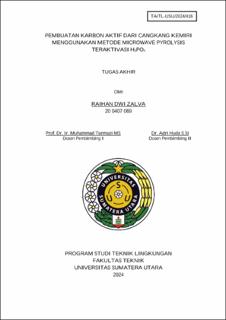Pembuatan Karbon Aktif dari Cangkang Kemiri Menggunakan Metode Microwave Pyrolysis Teraktivasi H3PO4
Preparation of Activated Carbon from Candlenut Shells Using Microwave Pyrolysis Activated with H3PO4

Date
2024Author
Zalva, Raihan Dwi
Advisor(s)
Turmuzi, Muhammad
Huda, Adri
Metadata
Show full item recordAbstract
Candlenut shells, an abundant waste, possess a high potential to be processed into Candlenut Shell Activated Carbon (CSAC). Activated carbon has numerous applications, such as an adsorbent, catalyst, and electrode. Microwave pyrolysis is an efficient method for producing activated carbon due to microwaves ability to accelerate reactions, and H3PO4 is an effective activator for increasing surface area and adsorption capacity. This research aims to produce activated carbon from Candlenut shells using microwave pyrolysis and activation with H3PO4. The research variables are the activator ratio, activation time, and activation power on the methylene blue adsorption capacity. To obtain the optimal value, modeling was done using Response Surface Methodology. Candlenut shells (CS) were washed, dried and ground into a biosorbent, then activated with H3PO4 at doses of 0.75, 1.375, and 1:2 g/g. Subsequently, activation was carried out in a microwave for 5, 10, and 15 minutes at a power of 450, 600, and 800 watts, followed by methylene blue (MB) adsorption to obtain the highest adsorption capacity from the experiment. The RSM modeling results showed that an activator ratio of 1:2 g/g, activation time of 15 minutes, and activation power of 450 watts produced activated carbon with the best surface area and adsorption capacity, with an adsorption capacity of 1093.548 mg/g. SEM characterization showed a pore structure, FTIR indicated functional groups consistent with activated carbon elements, and BET Surface Area showed a surface area of 154.144 m²/g with a micropore type.
Collections
- Undergraduate Theses [404]
